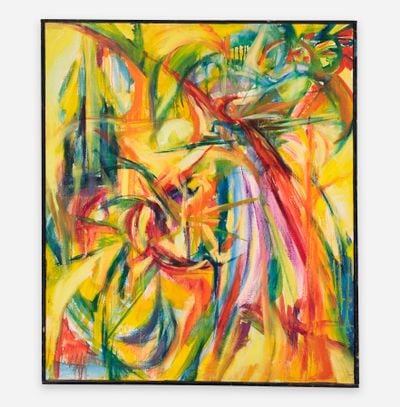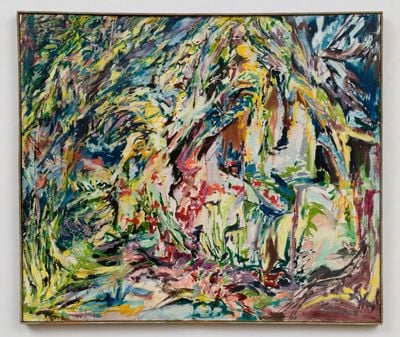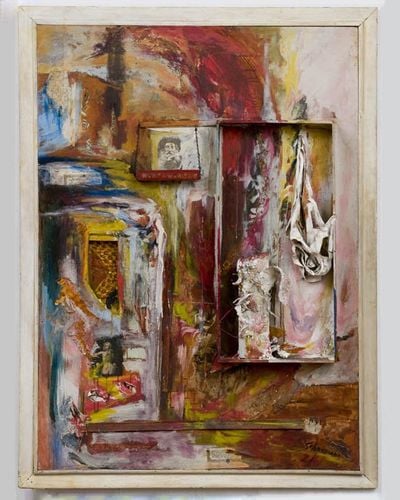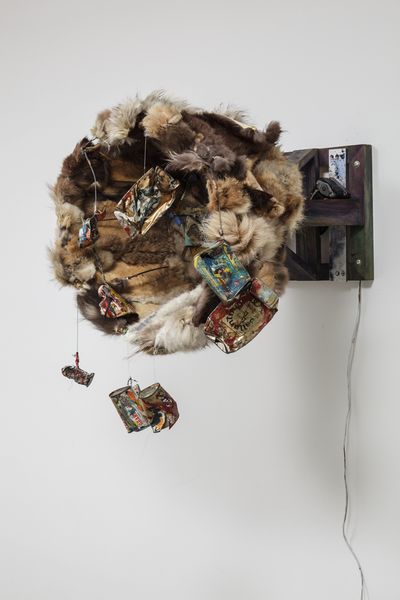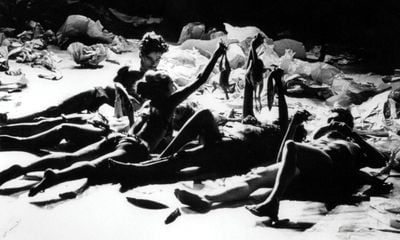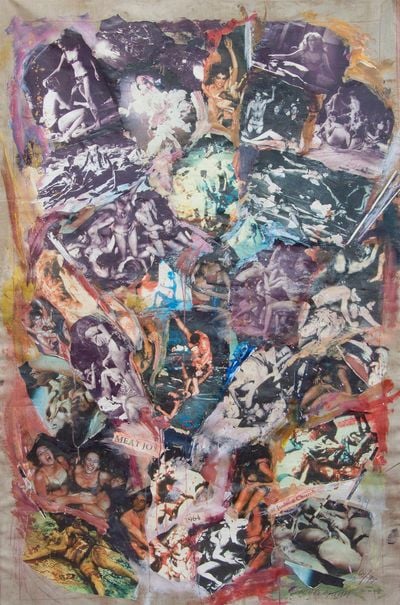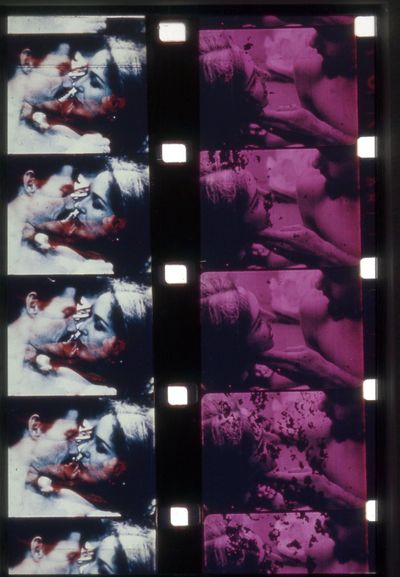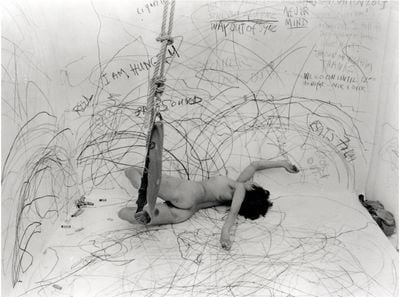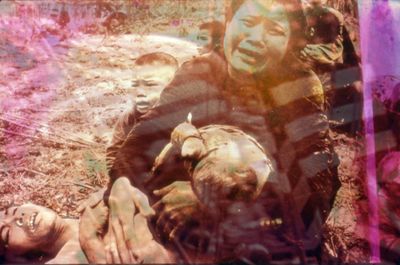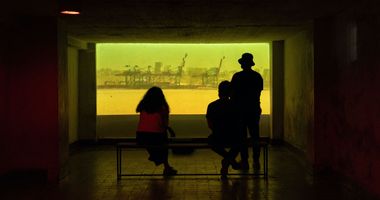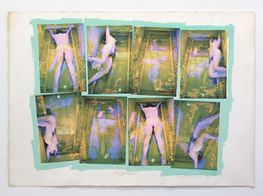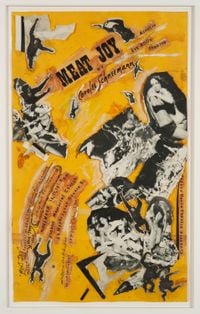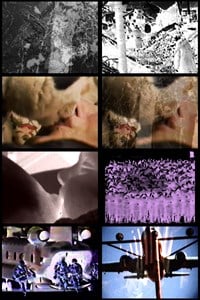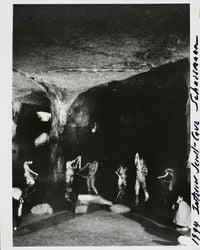Carolee Schneemann: What Painting Became
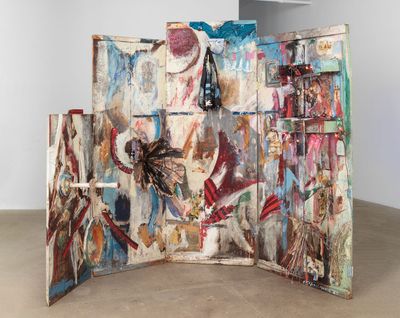
Carolee Schneemann, Four Fur Cutting Boards (1962–1963). Wooden boards, oil paint, light bulbs, string of coloured lights, plastic flowers, photographs, fabric, hubcap, tights, and motorised umbrellas. 229.9 x 332.7 x 132.1 cm. Courtesy © Carolee Schneemann. Artists Rights Society [ARS]/Copyright Agency, 2022.
In 2009, I curated an exhibition of Carolee Schneemann's paintings for P·P·O·W Gallery in New York City. It was the first time her paintings had been exhibited publicly in almost 40 years.
The exhibition, titled Carolee Schneemann: Painting. What It Became, featured 27, newly conserved works, including a re-construction of her Four Fur Cutting Boards (1963), the massive multi-media installation in front of which she photographed Eye Body, which had been languishing in her storage for decades. (I remember running down to Canal Street in New York with her to find an old fashioned-looking umbrella and flashing Christmas lights for the re-construction. It is now in MoMA's collection.)
The exhibition received rave reviews in the New York Times, The New Yorker, Artforum, The Brooklyn Rail, The Village Voice, and others. Carolee and I were elated.
Indeed, just before her death, Carolee told me that that exhibition and my re-discovery of her paintings was a game-changer for her career, and the sale of those works transformed her market value at a time when she was struggling financially.
Before that time, no one had bothered to look at her paintings, including her dealers, as important components of her decades-long practice. She had become somewhat pigeonholed as a performance artist, while other dimensions of her complex oeuvre were overshadowed by certain canonical works.
My hope is that my catalogue essay, the text of which is reproduced here, will help scholars, curators, and collectors to better understand her brilliant, early paintings. I also hope that this essay highlights the importance of the 2009 exhibition as a groundbreaking moment for Schneemann, especially given that all subsequent exhibitions of her work then included her paintings.
The Paintings of Carolee Schneemann1
Carolee Schneemann's paintings from the late 1950s and 1960s have been a significantly overlooked aspect of her oeuvre. Eclipsed by her signature works in performance and film, the paintings have often been considered early or immature work rather than an artistic foundation fundamental to understanding the entirety of Schneemann's practice.
This essay traces Schneemann's works from 1957 to the present, highlighting the transformation from traditional paintings on canvas in the lineage of abstract expressionism to painting constructions and kinetic sculptures to group and solo performances, installations, and films.
I'm a painter. I'm still a painter and I will die a painter. Everything that I have developed has to do with extending visual principles off the canvas.2
Taking this historical trajectory through Schneemann's work demonstrates how her explorations within other mediums derive from 'extending visual principles off the canvas.'
It helps to appreciate her paintings and drawings as important corollaries to the kinetic theatre, Judson Dance Theatre performances, and films that she was producing simultaneously.
The essay's intention is to reconsider Schneemann as a painter who has never ceased conceptualising her work as always related to the painterly gesture, to prying open 'the frame,' and to conceiving of the body itself as tactile material.
Her most significant works, treasured by many, misunderstood by some, can be re-envisioned, then, as what Schneemann herself has called, 'exploded canvasses'3 or as performative paintings, filmic paintings, kinetic paintings—always with the pictorial concerns of painting remaining as the grounding mechanism and unifying field.
Schneemann's formal training as an artist began in landscape painting and with endless hours of life drawing, as is evident in her early works on canvas—such as Summer I (Honey Suckle) (1959)—that reveal her signature luscious brushwork and all-over compositions.
These late 1950s pre-New York works also reflect a love of paint's tactility, its materiality, its objecthood—an important concept that assisted Schneemann in moving the gesture farther off the canvas.
Schneemann moved to New York City in 1961 after finishing her master of fine arts in painting at the University of Illinois. Almost immediately, she became situated squarely within what in the 1960s was called the 'experimental avant-garde,' a place also occupied by Robert Rauschenberg, Claes Oldenburg, Allan Kaprow, Jim Dine, and other second-generation abstract expressionist artists.
Indeed, like them, Schneemann was interested in exploring the new aesthetic options made available in the wake of Action Painting.
How could Jackson Pollock and Willem de Kooning's spatial fracture be expanded beyond the canvas and into space and time? Schneemann's intermedia works from the late 1950s through the 1970s demonstrate her continuous investigation of this question.
Schneemann's painting constructions—like Richard Stankiewicz's junk sculptures, Rauschenberg's 'combines,' Oldenburg's painted corrugated cardboard reliefs, or John Chamberlain's crushed auto assemblages—cull together non-art materials from life, ones that retain biographical references and which, in their rawness, call to mind the appearance and spirit of spatial analysis in painting.
Schneemann's Quarry Transposed (1960), Sphinx (1961), Sir Henry Francis Taylor (1961), Fur Wheel (1962), and Notes to Lou Andre Salomé (1965) are large painting constructions that exemplify her interest in assemblage and departure from the flat canvas.
In each, paint becomes one of many materials from life that can be applied to or cut into surfaces, along with photographs, wood, fabric, audiotape, glass, cellophane, underpants, and so forth.
Each demonstrates the artist's continued desire to push painting through the canvas, out of the frame, and into the spectator's space, while at the same time structuring the 'real' with the visual composition of a painter's eye.
Fur Wheel adds the element of movement, signalling Schneemann's entry into kinetic sculpture and leading to the incorporation of duration in her work.
In 1962 Schneemann began a large kinetic painting construction called Four Fur Cutting Boards built of four interlocked painted panels, with broken glass, mirrors, photographs, coloured lights, moving umbrellas, a hubcap, fabric, and other, motorised, parts. It is an imposing environment, painted in brightly coloured, gestural sweeps.
A year later, this became an integral material component for Schneemann's Eye Body: 36 Transformative Actions, one of her most famous works, which blended painting, performance, and photography. In each of the 'actions for camera' the artist combined her naked, painted body as an additional tactile, plastic 'material' with the painting construction.
This was the first time Schneemann incorporated her physical body into the form of her work, permeating boundaries between image maker and image, seeing and seen, eye and body—hence, the title, Eye Body, suggesting as Rebecca Schneider has written, an 'embodied vision, a bodily eye—sighted eyes—artist's eyes—not only in the seer, but in the body of the seen.'4
Schneemann's positioning of herself within her own work as an active seeing agent and her insistence on emphasising her body as tactile material contributed greatly to the development of her ideas of kinetic theatre.
As a founding member of the Judson Dance Theater, along with Yvonne Rainer, Steve Paxton, Elaine Summers, and others, Schneemann's primary interest was in kinesthesia, or bodily sensations, hence, her chosen term 'kinetic theater' to describe her early performance productions involving multiple participants.
In her very first kinetic theater piece in 1962, Glass Environment for Sound and Motion, Schneemann conceived of the stage as 'an enlarged collage,' replete with large broken, refracted mirrors, and the performers in the group 'as a sort of physical palette,' clearly demonstrating a circulation of ideas between the concatenated elements in her studio production of Four Fur Cutting Boards and the treatment of the body as material in Eye Body.
In each of her numerous works produced throughout the 1960s at the Living Theater or at the Judson Dance Theater, the artist conceptualised her works 'as a painter who had in effect enlarged her canvas.' As she explained in an interview in 1983, her theater works were 'taking Pollock, the gesture, the action, into space.'5
Meat Joy (1964) is Schneemann's most famous kinetic theater performance. Accompanied by a collaged soundtrack of Paris street noises and upbeat pop tunes, eight seminude women and men (including the artist) roll about in mounds of paper, embrace, make living sculptures, come together, part, paint each others' bodies, and in the end are inundated with raw chickens, fish, and sausage.
As in a later solo performance, Body Collage (1967), in which Schneemann paints her nude body with molasses and glue and then rolls in paper to produce a literal 'body collage,' the participants' bodies in Meat Joy function as both canvasses and paintbrushes, performing abstract expressionist painting as they actively move about the arena of the canvas while also providing the ground upon which colour, shape, and texture accumulate.
Schneemann has equated Meat Joy with performative painting, describing it as 'an erotic vision that came through a series of very visceral dreams of expanding physical energy—off the canvas, out of the frame.'6
Indeed, three painted collages on linen made decades later to commemorate the performance, titled Meat Joy Collage (1998–1999), which incorporate original photographs from 1964, are aggressively gestural in execution, and return the embodied, explosive energy of the 'real' performance to its visual analogy.
When Schneemann first performed Meat Joy in Paris she realised that documenting it was a critical part of the event. Both film and photography were used to communicate the work's expressionist quality and to reveal its narrative structure.
Schneemann subsequently began to pursue film as a mixed-media form unto itself and, on occasion, within the context of performance.
Fuses (1964–1966), a silent film of collaged lovemaking sequences between Schneemann and her then-partner, composer James Tenney, observed by a cat, is considered by many to be one of her masterpieces. The formal ingenuities of Fuses—principally, the manoeuvring of celluloid material to subvert narrativity and subjectivity—place Schneemann at the forefront of experimental film's investigation of materiality and abstraction.
At the same time, its feminist content and her fluid, expressionistic, painterly treatment of the medium sets her apart from other mid-1960s experimental filmmakers' purely formalist bent.
My entire body becomes the agency of visual traces, vestiges of the body's energy in motion.
For Schneemann, film was a natural extension of the canvas: Fuses is a filmic painting. Schneemann hand-painted, etched, dyed, stamped, scratched, baked, and heavily collaged the surface of the film, producing a physically thick, textured film object not unlike the surfaces of the painting constructions she was making simultaneously.
As the artist explains, 'As a painter ... I wanted the bodies to be turning into tactile sensations of flickers.' For the viewer, the naked bodies move in and out of the frame, dissolving optically before their eyes, not a literal translation but 'edited as a music of frames.'7
Schneemann's solo performance, Up To and Including Her Limits (1973–1977), insofar as it is a direct commentary on the hyper-masculinity of action painting, as well as the sexualised nature of Pollock's 'ejaculatory drip' in particular, also represents one of the best examples of what painting became as it moved through her body: a total integration of action and object.
Suspended naked above her canvas, Schneemann manually raised and lowered herself while 'stroking' the surrounding floor and walls with crayons, accumulating a web of coloured marks, vestiges of the body's energy in motion.
I'm a painter, working with my body and ways of thinking about movement and environment that come out of the discipline of having painted for six or eight hours a day for years.
As Schneemann explained in 1977, Up To and Including Her Limits is the direct result of Pollock's physicalised painting: 'My entire body becomes the agency of visual traces, vestiges of the body's energy in motion.'8
A few years later, in 1983, the artist produced a kinetic sculpture titled War Mop, which similarly continues her investigation into the definition of what constitutes painting post-Action Painting and challenges the gender signification of its gesture.
It also demonstrates how painting persists as a theme, even when Schneemann's literal or 'real' body ceases to function as a subject, agent, or 'material.'
Like her earlier Vietnam inspired film Viet Flakes of 1967, War Mop is a protest work, in this instance against the atrocities in Beirut. On a video monitor, Schneemann's montage of news footage from the war, Souvenir of Lebanon (1983), plays continuously.
Every eight seconds the motorised mop rises then slaps down on the monitor, like a weapon or rifle, as violent images of blown-out villages sweep across the screen. The hostile and banal movement of the mop, up and down, metaphorically echoes the aggressive paint strokes of the abstract expressionists, turning the mop into an oversized paintbrush.
That Schneemann conceives of her motorised mop as a paintbrush is undeniable. In 1990–1991, she produced an important work entitled Scroll Painting with Exploded TV, in which a series of paintings was created by motorised mops dipped in paint. In the installation, video monitors depict the paint falling on the canvas.
If gestural abstraction was initially about the reclamation of subjectivity in post–World War America, as Pollock's declaration, 'I am nature,' would seem to imply, then, Schneemann's complete elimination of the subject from the creation of 'gestural abstraction' is her rebuttal.
Despite her innumerable, intermedia explorations through kinetic theatre, performance, film, video, and installation, and decades of artistic production in which the physical medium of paint is scarce, Schneemann insists on her status as a painter.
As she eloquently states in a 1980 interview: 'I'm a painter, working with my body and ways of thinking about movement and environment that come out of the discipline of having painted for six or eight hours a day for years. That's got to be the root of my language in any medium. I'm not a filmmaker. I'm not a photographer. I'm a painter.'9
To unravel this seeming contradiction, a redefinition of the painter needs to be supported, not as one who paints but one who works on the questions and problems of painting. This shift allows a deeper appreciation for the power of visual structures and formal concerns throughout Schneemann's career.
It also places her work at the centre of the major philosophical debates raised by contemporary art, challenging the flatness of painting, and notions of medium specificity, and expanding the field of visual art to include the embodied subject.

